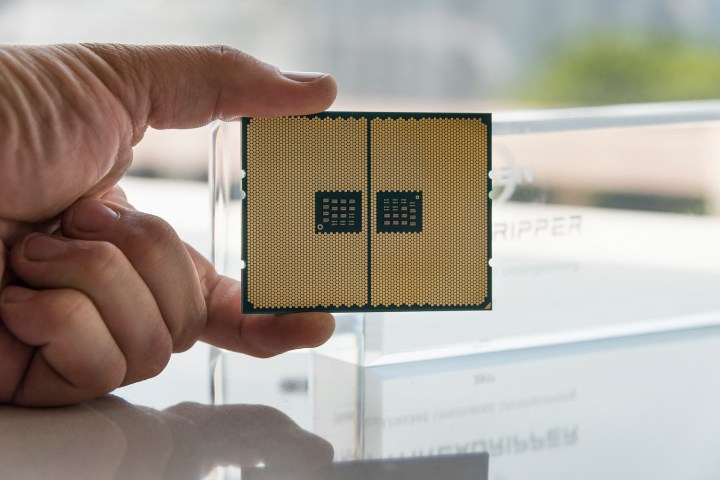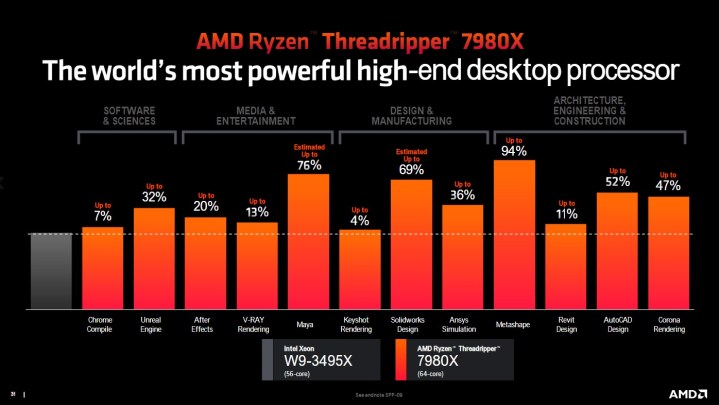
AMD is putting its foot down. In what Donny Woligroski, senior processor technical marketing manager at AMD, called the “worst-kept secret” in the world of desktop processors, Team Red announced it’s bringing its wildly popular Threadripper chips back to high-end desktops. They’re destined to be some of the best processors money can buy, and Intel currently has no way to compete.
If you’re not up to speed, AMD quietly and unceremoniously ended its Threadripper series for desktops a little over a year ago. When the company announced its previous generation of Threadripper CPUs, it revealed it would stick with the Enterprise-grade Pro series chips going forward. A little over 12 months after that announcement, AMD is reversing course.
The new Threadripper 7000 series is split into Pro and non-Pro parts, with the consumer parts reaching up to 64 cores and 128 threads. AMD has dominated the server market with its Epyc CPUs for years now, but in consumer desktops, AMD and Intel have been on mostly equal footing. That’s changing, as Intel doesn’t have any high-end desktop CPUs to effectively compete with AMD’s new Threadripper CPUs.
| Threadripper 7980X | Threadripper 7970X | Threadripper 7960X | |
| Cores/Threads | 64 / 128 | 32 / 64 | 24 / 48 |
| Total cache | 320MB | 160MB | 152MB |
| Max turbo frequency | 5.1GHz | 5.3GHz | 5.3GHz |
| TDP | 350W | 350W | 350W |
| List price | $5,000 | $2,500 | $1,500 |
As with previous Threadrippers, these are expensive chips targeted at users who need peak performance for work — or just for bragging rights. The massive core array brings power requirements up to 350 watts. You’ll also need a TRX50 motherboard, as well as CPU cooler with support for the massive chips. AMD has three high-end desktop Threadripper chips, all of which will be available on November 21.
Alongside the high-end desktop chips, AMD announced six new Threadripper Pro CPUs, reaching up to 96 cores and 192 threads. These are firmly targeted at businesses, and there are some important differences between the Pro and non-Pro chips.

The WRX90 platform Pro processors support Pro manageability features for large computing fleets, as well as up 148 total PCIe lanes (144 useable) and eight-channel memory. By contrast, the high-end desktop platform lacks Pro manageability features, comes with quad-channel memory, and supports a total of 92 PCIe lanes (88 useable). You also can’t use one of the high-end desktop versions on the Pro chipset.
That’s not true in the opposite direction, though. AMD says you’ll be able to take a Pro processor and slot it into a TRX50 motherboard. That means you could, with enough cash, pack a 96-core CPU into a high-end desktop. AMD says boxed versions of its Threadripper 7000 Pro CPUs will be available alongside the non-Pro models. Previously, AMD restricted its Pro chips to system builders only.
Below, you can see what the flagship Threadripper 7980X can do compared to a competing Xeon processor. Performance, ironically, doesn’t matter much for consumers, though. Intel doesn’t sell Xeon chips directly to consumers, so you’ll have to spend thousands through a wholesaler to find one. Currently, AMD is the only one that offers this level of computing power to high-end desktop users.

Of course, we still expect these chips will be powerful, much more so than anything Intel or AMD currently offers to end users. Threadripper 7000 CPUs are built on the same Zen 4 architecture powering processors as the Ryzen 9 7950X, just with a much higher core cluster.




